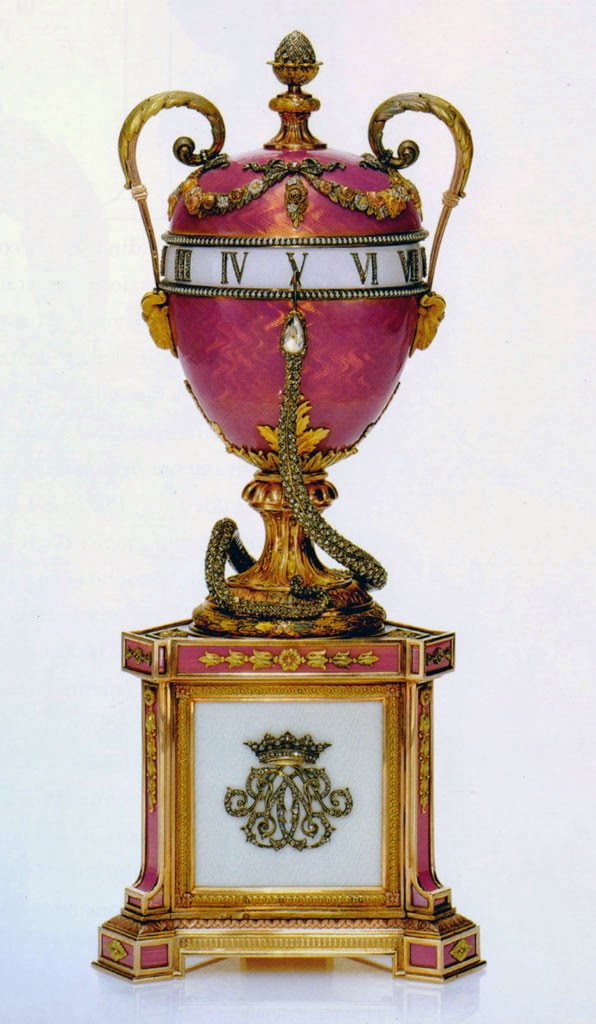It will come as a surprise to no-one who reads this blog that I love Faberge art objects. Now we hear an amazing story. A London antique dealer says a gold ornament bought by an American scrap-metal dealer has turned out to be a rare Faberge egg!! The clock egg had been purchased at an ordinary antique fair for about $14,000. This seems a lot for a small clock, yet the buyer SAID he only began to suspect its true value after seeing an article about the 50 imperial Faberge Easter eggs made for Russian royalty. He contacted the Faberge expert who verified it. The true value could be anything - in the last decade, Faberge eggs have sold for USA $15-20 million each.
The newly identified clock egg, 1887
Closed (above) and opened (below)
Clearly the gold marks on the object suggest it was an 1887 Easter gift from Czar Alexander III to his wife, Empress Maria Feodorovna. And in addition to the gold marks, the experts located written records in the Russian State Historical Archives. Described in the 1917 inventory of confiscated imperial treasure, the egg had to be moved from the imperial palace in Saint Petersburg (in 1922) to the Council of People's Commissars for safe keeping.
But here is the kicker. The egg, which contained a Vacheron Constantin watch, seems to be the very first of the Tsar Imperial Fabergé eggs to feature a working clock; in fact it is one of the very few clock eggs that have been located at all. You can examine those that have been identified at Mieks Faberge Eggs.
Let's examine the imperial Blue Serpent Clock Egg 1887 made by Mikhail Perkhin, one of the most important Fabergé workmasters ever. This egg stood on a base of gold that was painted in opalescent white enamel. The panels of the base featured motifs of raised gold in four colours, representing the arts and sciences. A serpent, set with diamonds, coiled around the stand connecting the base to the egg and up toward the centre of the egg. The serpent's head and tongue pointed to the hour which was indicated in roman numerals on a white band. This band rotated within the egg to indicate the time, rather than the serpent rotating around the egg. The egg was enamelled in translucent blue and had diamond-studded gold bands ringing the egg. On each side of the egg a sculpted gold handle was attached.
The best coverage of this topic is The History Blog. That blog notes that has been some confusion in the scholarly community over the missing eggs, particularly when they were made and what they looked like. "For many years experts thought the Blue Serpent Clock Egg, currently owned by Prince Albert II of Monaco, filled the 1887 spot on the timeline, but in fact it was made in 1885 and it’s one of those picture-less eggs, the Third Egg, that was gifted to Maria Feodorovna in 1887".
Duchess of Marlborough’s Pink Serpent Egg, 1902
The Duchess of Marlborough’s Pink Serpent Egg 1902 was similar. Once again made by Mikhail Perkhin, this clock egg was made in enamelled translucent rose pink over a guilloche ground, the white enamel chapter ring with diamond-set Roman numerals between borders of seed pearls. The top of the Egg was applied with varicoloured gold floral swags and diamond-set ribbon bows.
The newly discovered clock egg will be on display at Wartski’s London showroom in the middle of April 2014, the first time it will have been seen in public for 110 years.
The newly identified clock egg, 1887
Closed (above) and opened (below)
But here is the kicker. The egg, which contained a Vacheron Constantin watch, seems to be the very first of the Tsar Imperial Fabergé eggs to feature a working clock; in fact it is one of the very few clock eggs that have been located at all. You can examine those that have been identified at Mieks Faberge Eggs.
Let's examine the imperial Blue Serpent Clock Egg 1887 made by Mikhail Perkhin, one of the most important Fabergé workmasters ever. This egg stood on a base of gold that was painted in opalescent white enamel. The panels of the base featured motifs of raised gold in four colours, representing the arts and sciences. A serpent, set with diamonds, coiled around the stand connecting the base to the egg and up toward the centre of the egg. The serpent's head and tongue pointed to the hour which was indicated in roman numerals on a white band. This band rotated within the egg to indicate the time, rather than the serpent rotating around the egg. The egg was enamelled in translucent blue and had diamond-studded gold bands ringing the egg. On each side of the egg a sculpted gold handle was attached.
Blue Serpent Clock Egg 1887
The Duchess of Marlborough’s Pink Serpent Egg 1902 was similar. Once again made by Mikhail Perkhin, this clock egg was made in enamelled translucent rose pink over a guilloche ground, the white enamel chapter ring with diamond-set Roman numerals between borders of seed pearls. The top of the Egg was applied with varicoloured gold floral swags and diamond-set ribbon bows.
The newly discovered clock egg will be on display at Wartski’s London showroom in the middle of April 2014, the first time it will have been seen in public for 110 years.



